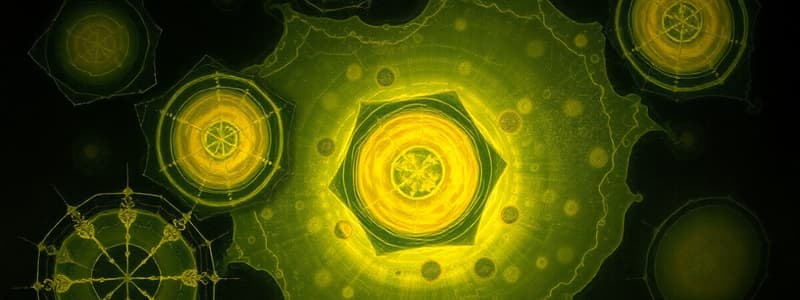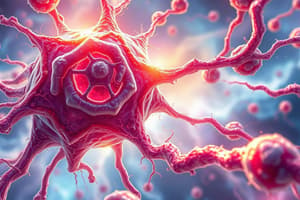Podcast
Questions and Answers
Who was the first to discover living cells?
Who was the first to discover living cells?
- Anton von Leeuwenhoek (correct)
- Robert Hooke
- Mathias Schleiden
- Theodor Schwann
What is the primary distinction between prokaryotic and eukaryotic cells?
What is the primary distinction between prokaryotic and eukaryotic cells?
- Eukaryotic cells have cell walls
- Prokaryotic cells contain mitochondria
- Eukaryotic cells reproduce faster
- Prokaryotic cells do not have a nucleus (correct)
Which of the following is a function of the mitochondria?
Which of the following is a function of the mitochondria?
- Protein synthesis
- ATP production (correct)
- DNA replication
- Photosynthesis
Which statement accurately reflects the similarities between plant and animal cells?
Which statement accurately reflects the similarities between plant and animal cells?
What part of the cell is responsible for controlling cell activities?
What part of the cell is responsible for controlling cell activities?
Which of the following statements about the differences between plant and animal cells is incorrect?
Which of the following statements about the differences between plant and animal cells is incorrect?
What is the product produced by the cell called?
What is the product produced by the cell called?
Which cell part is directly responsible for the synthesis of ribosomes?
Which cell part is directly responsible for the synthesis of ribosomes?
Where are ribosomes primarily attached within a cell?
Where are ribosomes primarily attached within a cell?
Which cell part inspects, sorts, and ships proteins assembled by ribosomes?
Which cell part inspects, sorts, and ships proteins assembled by ribosomes?
What is the primary function of vacuoles in plant cells?
What is the primary function of vacuoles in plant cells?
What structure creates a barrier that controls what enters and leaves the cell?
What structure creates a barrier that controls what enters and leaves the cell?
Which structure in plant cells provides additional protection beyond the cell membrane?
Which structure in plant cells provides additional protection beyond the cell membrane?
Flashcards are hidden until you start studying
Study Notes
Definition and Discovery of Cells
- Cells are the smallest unit of life.
- Robert Hooke first discovered dead cells.
- Anton von Leeuwenhoek was the pioneer in discovering living cells.
Contributions to Cell Theory
- Mathias Schleiden observed that all plants are made of cells.
- Theodor Schwann noted that all animals consist of cells.
- Rudolph Virchow concluded that cells arise from existing cells.
- Three fundamental components of the cell theory:
- All living things are composed of cells.
- The cell is the fundamental unit of life.
- Cells originate from other living cells.
Prokaryotic vs Eukaryotic Cells
- Prokaryotic cells predate eukaryotic cells.
- Prokaryotic cells lack a nucleus and membrane-bound organelles, while eukaryotic cells possess these features.
- Similarities between both types include cell membranes, chromosomes/DNA, ribosomes, and cytoskeleton.
Examples of Cells
- Prokaryotic example: Bacterial cell.
- Eukaryotic examples: Plant cell and animal cell.
Plant and Animal Cell Comparisons
- Both contain membranes, nuclei, chromosomes, ribosomes, endoplasmic reticulum, Golgi apparatus, mitochondria, and cytoskeleton.
- Differences:
- Plant cells have cell walls, vacuoles, and chloroplasts; animal cells do not.
- Animal cells possess flagella, lysosomes, and centrioles; plant cells do not.
- Plant cells are typically square; animal cells are round.
Cell Functionality
- Cells compared to factories for their collaborative functioning.
- ATP is the energy used by cells.
- Mitochondria produce ATP and are termed the powerhouse of the cell.
Energy Production in Cells
- Animal cells obtain energy through consuming food, while plant cells convert sunlight into energy via chloroplasts through photosynthesis.
Nucleus and Ribosomes
- The nucleus serves as the control center, housing the instructions for product creation.
- The nucleolus produces ribosomes.
- Chromatin or DNA in the nucleus contains the genetic instructions for protein synthesis.
Protein Production Process
- Ribosomes are responsible for assembling proteins.
- Ribosomes can be found on the Rough Endoplasmic Reticulum (Rough ER).
- After assembly on the Rough ER, proteins are sent to the Golgi apparatus for inspection, sorting, and shipping.
- The Golgi apparatus can send proteins out of the cell through Golgi vesicles or route them to lysosomes for degradation.
Cell Storage and Waste Management
- Vacuoles act as storage for cellular materials; they are larger in plant cells and play a role in homeostasis and storing water.
- Lysosomes function as the cell's waste disposal system.
Cell Membrane and Barriers
- The cell membrane regulates the entry and exit of substances, creating a protective barrier.
- Plant cells have an additional protective layer called the cell wall, providing extra support.
Cell Movement Structures
- Flagella are long tails used for movement, while cilia are small hair-like structures that also assist in movement.
- Cytoplasm serves to cushion and support the organelles within a cell.
Studying That Suits You
Use AI to generate personalized quizzes and flashcards to suit your learning preferences.




